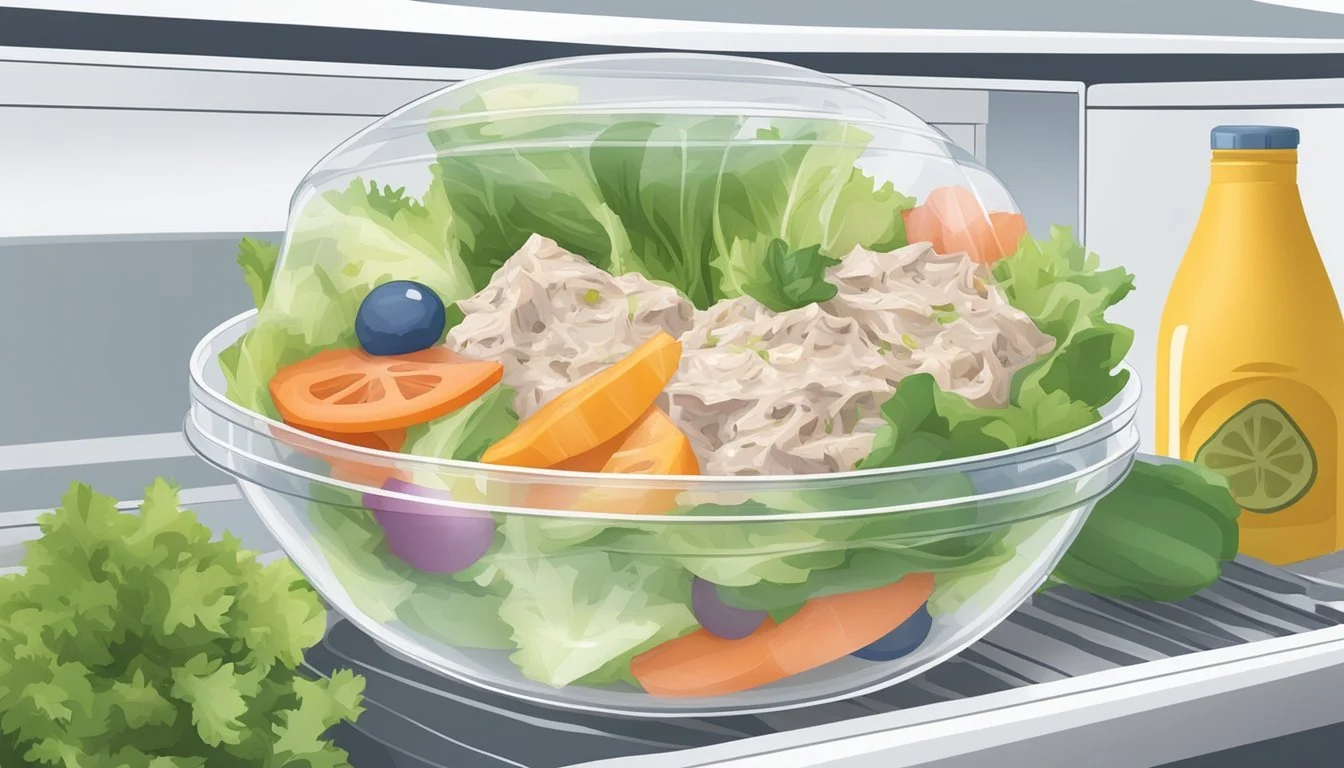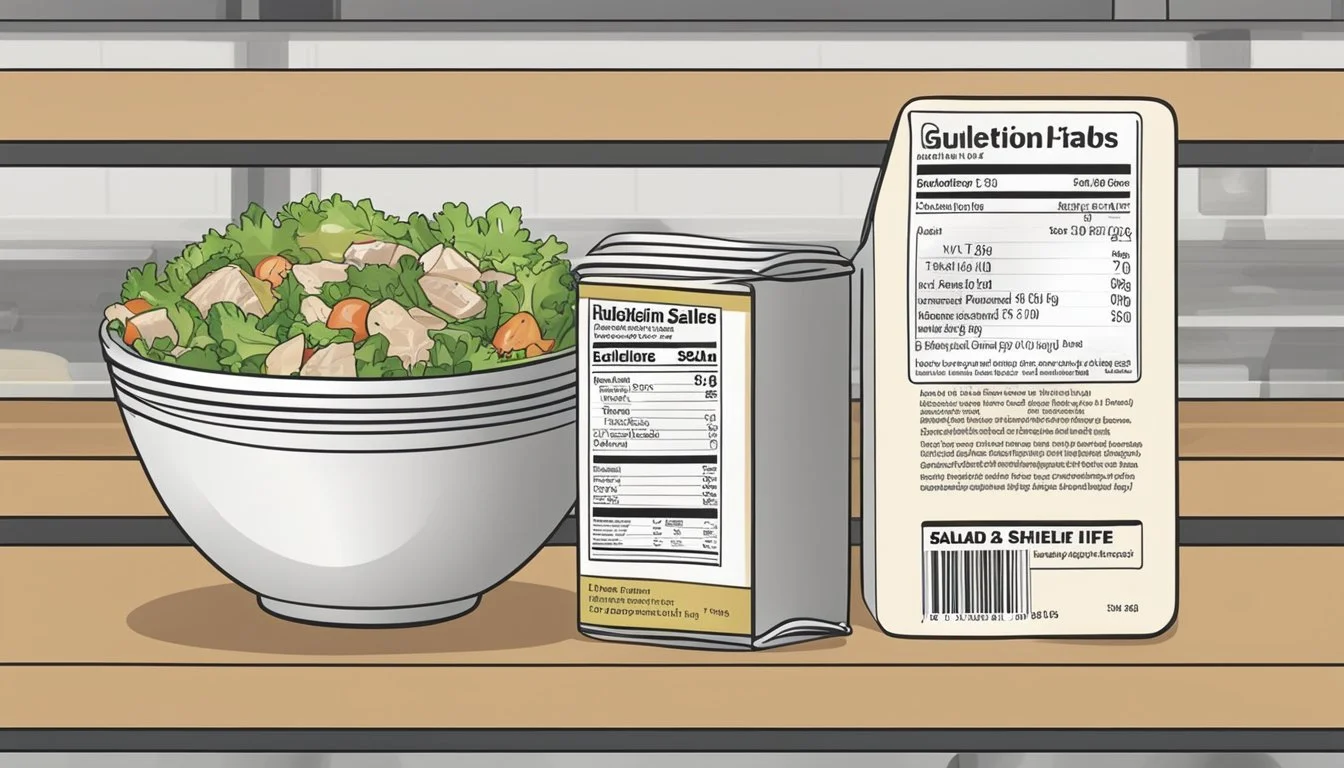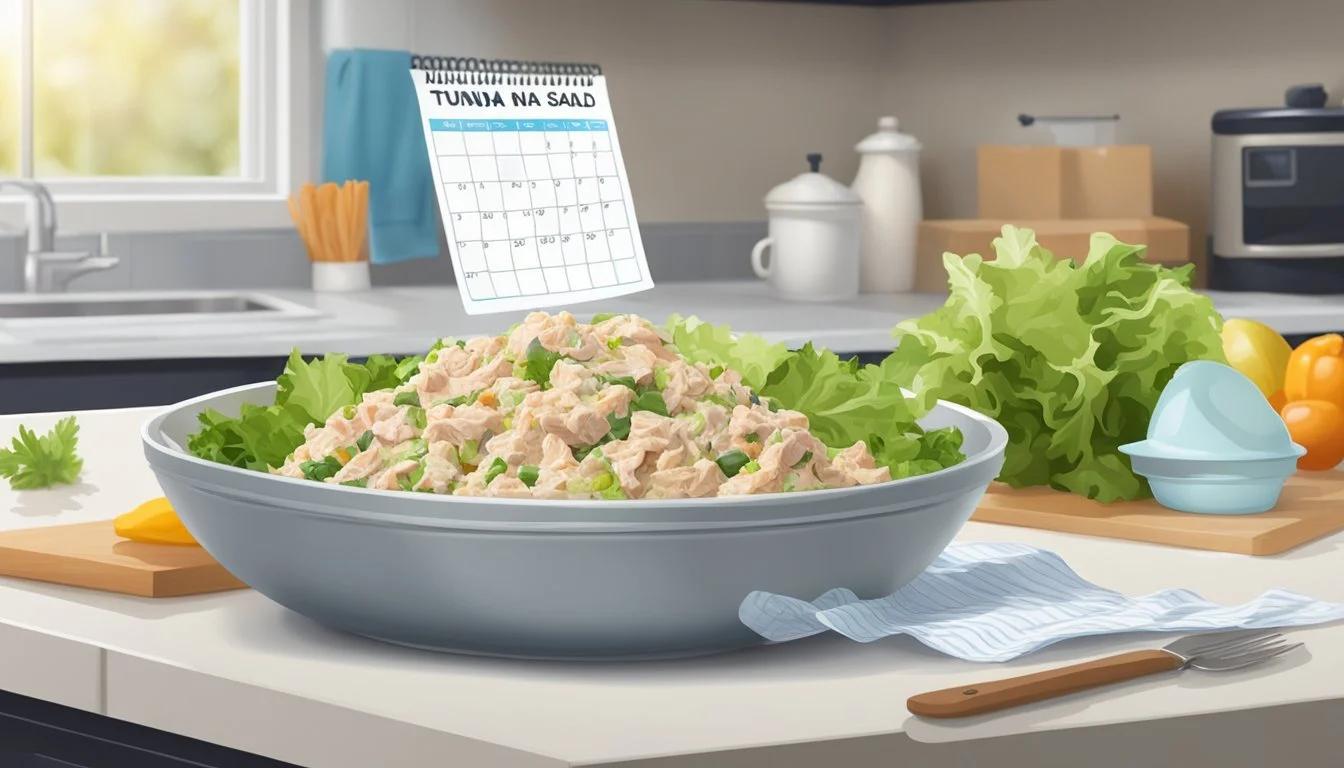How Long Does Freshly Prepared Tuna Salad Last?
Shelf Life Guide
When it comes to storing food safely and maintaining its freshness, understanding the shelf life of perishable items like tuna (What wine goes well with tuna?) salad is crucial. Freshly prepared tuna salad consists of a mixture of tuna, typically canned, and various ingredients such as mayonnaise, celery (how long does celery last?), onions, and sometimes hard-boiled eggs or relish. Its shelf life is largely dependent on the perishability of these ingredients, together with the temperature and conditions of storage.
Generally, tuna salad is safe to consume from the refrigerator for 3-4 days if it is stored promptly and properly in conditions below 40°F (4°C). Given that it contains mayonnaise or other dairy-based dressings, it is susceptible to spoilage due to bacterial growth if left at room temperature for extended periods. It is consistently advised to store tuna salad in airtight containers to maximize its freshness and to consume it within the recommended time frame.
Food safety authorities stress the importance of adhering to these guidelines to avoid foodborne illnesses. They also recommend that if the tuna salad has been left out at room temperature for more than two hours, particularly in warmer climates or settings above 90°F (32°C), it should be discarded for safety reasons. It's essential to rely on both sensory inspection—checking for off odors, flavors, or textures—and adherence to suggested storage practices when determining the edibility of the tuna salad.
Fundamentals of Tuna Salad Preservation
Proper preservation of tuna salad is essential to maintain its freshness and safety for consumption. The length of time tuna salad remains edible relies heavily on several key factors and the conditions under which it is stored.
Factors Affecting Freshness
Temperature: Tuna salad should be kept at a consistent temperature of 40 °F (4 °C) or below to minimize the risk of bacterial growth.
Components: Ingredients in tuna salad, such as mayonnaise or other dairy products, can influence its shelf life. These components may reduce the time the salad can be safely consumed.
Optimal Storage Conditions
Refrigeration: Storing tuna salad in the refrigerator is non-negotiable for preserving its freshness. Homemade tuna salad should be placed in the fridge within two hours of preparation.
Airtight Container: To maximize shelf life, one must store the salad in an airtight container. This prevents contamination and maintains the quality of the salad.
Shelf Life: Adhering to USDA guidelines, refrigerated tuna salad is generally good for 3-4 days. Observing these storage conditions is crucial in ensuring the salad remains fresh and safe to eat.
Understanding Spoilage
When determining the shelf life of tuna salad, recognizing spoilage is crucial for food safety, as consuming spoiled food can lead to food poisoning. It is essential to observe the physical signs of spoilage and understand the conditions that encourage bacterial growth.
Identifying Signs of Spoilage
Tuna salad exhibits specific signs when it begins to spoil. These indicators include:
Smell: A sour or ammonia-like odor can suggest bacterial activity.
Visual: The presence of mold or unusual color changes point to spoilage.
Texture: A slimy or overly mushy consistency is another sign.
If any of these signs are apparent, the tuna salad should not be consumed.
Bacterial Growth and Food Safety
Bacteria thrive in the "danger zone" between 40°F and 140°F, significantly increasing the risk of foodborne illness. To minimize bacterial growth:
Temperature Control: Tuna salad should be stored below 40°F.
Time Frame: It should not be left out at room temperature for more than 2 hours.
Adhering to these principles ensures that the salad remains within a safe consumption window, typically 3-5 days when properly refrigerated.
Proper Refrigeration Techniques
Ensuring tuna salad retains its freshness hinges on employing effective refrigeration techniques. Properly stored, tuna salad can maintain quality for a designated period before potentially going bad.
Refrigeration vs. Freezing
Refrigeration is recommended for tuna salad, as it helps maintain the salad's texture and flavor. The optimal temperature for refrigeration is 40 °F (4 °C) or below, in line with USDA recommendations. In contrast, freezing is not advisable for tuna salad because freezing may significantly deteriorate the creamy texture, making the dish unpalatable upon thawing.
Best Practices for Refrigerated Storage
When it comes to refrigerated storage, several best practices can prolong the freshness of tuna salad:
Always store tuna salad in airtight containers to minimize exposure to air, which can expedite spoilage.
Label the container with the preparation date for easy tracking, and consume within 3-5 days.
Place the tuna salad in the coldest part of the refrigerator, usually at the back, rather than in the door where temperature fluctuations are more common.
Regularly check if food has gone bad. Signs include a sour smell, a change in texture, or any visible discoloration. If suspected, it is best to discard the salad to prevent foodborne illness.
Shelf Life Guidelines
When it comes to the shelf life of freshly prepared tuna salad, the key factors to consider are the freshness of the ingredients at the time of preparation and how the salad is stored. These factors significantly influence how long the tuna salad remains safe and enjoyable to eat.
Estimated Shelf Life
The typical shelf life of homemade tuna salad, when refrigerated at or below 40°F (4°C), ranges from:
3 to 4 days, adhering to the guidelines recommended by FoodSafety.gov and the USDA
Up to 5 days, if the ingredients used are exceptionally fresh and the storage conditions are ideal
A precise timeline is difficult to guarantee due to variations in ingredient freshness and storage practices. It's essential to consider the "use by" dates on ingredients like mayonnaise and canned tuna, as these can also affect the salad's overall longevity.
Impact of Ingredients on Longevity
The individual ingredients in tuna salad affect its shelf life:
Canned tuna: Generally has a long shelf life until opened. Once included in the salad, it should be eaten within the recommended 3-5 days.
Mayonnaise (mayo): If made with mayo, homemade tuna salad may become unsafe to eat faster due to mayo's sensitivity to temperature changes.
Fresh ingredients: Vegetables or other perishables mixed in can be the first to spoil, thereby shortening the salad's freshness window.
To maximize shelf life and safety, one should always:
Store tuna salad in an airtight container.
Keep the refrigerator temperature consistently below 40°F.
Avoid cross-contamination during preparation and storage.
Consumption and Quality Control
Making sure tuna salad remains safe to eat and maintains its flavor requires attention to storage time and quality assessment. Recognizing the signs of spoilage can prevent health issues related to consuming bad tuna.
Assessing Quality Before Eating
Before consuming tuna salad, it is necessary to inspect for any signs of spoilage. Quality indicators include:
Flavor: Fresh tuna salad should have a clean, mildly fishy flavor. If the taste is sour or unusually strong, it may indicate spoilage.
Smell: A fresh batch should have a mild scent. Strong, unpleasant, or strange odors suggest that the tuna salad should be discarded.
Inspecting the tuna salad before consumption is vital to avoid health risks associated with spoiled food.
Health Risks of Spoiled Tuna Salad
Eating spoiled tuna salad can lead to foodborne illnesses. Symptoms to watch for include:
Nausea
Diarrhea
Vomiting
Stomach cramps
These symptoms can occur if perishable food like tuna salad is stored for too long or at inadequate temperatures. Tuna salad lasts typically between 3 to 5 days in the fridge, beyond which it is considered risky for consumption and should be discarded.
Special Considerations for Tuna Salad Variations
In making variations of Tuna Salad, one must consider how certain additives and alternative ingredients may affect shelf life and freshness.
Additives and Their Effects
Mayonnaise: The traditional base for tuna salad, mayonnaise is a perishable ingredient that reduces the salad's shelf life to 1-2 days when added.
Greek Yogurt: As a substitute for mayonnaise, Greek yogurt can offer a tangier taste and similar shelf life. However, Greek yogurt should be used promptly as it can spoil quickly.
Lemon Juice: This citrus additive enhances flavor and can slightly extend freshness due to its acidic nature. Lemon juice should be fresh squeezed for best results.
Eggs: Hard-boiled eggs are a common addition. They must be properly refrigerated and can cause the salad to spoil more quickly, within 3 days.
Spices: Spices like dill can add complexity to the flavor but do not significantly alter the shelf life.
Alternative Ingredients and Freshness
Avocado: A rich and creamy alternative to mayo, avocado changes the consistency and should be eaten within 1-2 days as it browns quickly.
Onions & Relish: These ingredients may introduce additional moisture, which can affect the salad's shelf life. They should be well-drained before adding.
Yogurt: As an alternative to mayo, non-fat or low-fat yogurt can be used, which may extend the shelf life slightly compared to full-fat mayonnaise but still requires refrigeration and should be used within a similar timeframe.
Albacore Tuna: This premium tuna variant, when used in place of regular tuna, has a milder taste and contains more Omega-3s but does not significantly affect the shelf life of the salad.
In using these ingredients, it is essential to remember that proper storage in an airtight container at the back of the fridge is crucial for maximising freshness.
Handling and Disposal
Proper handling and disposal of tuna salad are crucial to prevent foodborne illness. They ensure the individual's safety by avoiding the consumption of spoiled food.
When to Discard Tuna Salad
Tuna salad should be discarded if it has been stored in the refrigerator for more than 3-5 days. Signs that tuna salad has spoiled include an unpleasant scent or a slimy texture. If the salad has been left at room temperature for more than 2 hours, or 1 hour in temperatures above 90°F (32.2°C), it should be thrown away to prevent the risk of bacterial contamination.
Disposal Recommendations
When discarding tuna salad, it should be placed in a sealed bag or container to prevent the spread of any potential contamination. One should then dispose of it in the garbage. To avoid attracting pests or causing unpleasant odors, ensure the garbage bin is secured and emptied regularly.
Additional Tips and Tricks
To maximize the enjoyment of your tuna salad, it's essential to know the best practices for maintaining its freshness and discovering innovative ways to repurpose any leftovers. Thorough attention to storage and a touch of culinary creativity can significantly enhance your experience.
Enhancing Tuna Salad Shelf Life
When it comes to prolonging the life of your tuna salad in the refrigerator, one can take several proactive steps. Storage tips are crucial; the key is to minimize the tuna salad's exposure to air:
Use Airtight Containers: Opt for glass containers with tight-fitting lids to store your tuna salad. Glass is less likely to absorb odors and can keep the contents fresher.
Temperature Management: Keep your tuna salad at a consistent 40 °F (4 °C) or below, which is the safe zone to slow bacterial growth.
Freezer Storage: For longer shelf life, one can freeze tuna salad, although this may affect the texture, especially if it contains crunchy vegetables or mayonnaise. Use freezer-proof containers.
When thawing frozen tuna salad, transfer it to the refrigerator and allow it to thaw slowly. It is not recommended to refreeze tuna salad once thawed.
Creative Uses for Leftover Tuna Salad
Should you find yourself with excess tuna salad, there are several creative ways to incorporate it into new meals:
Lettuce Wraps: Spoon the salad into crisp lettuce leaves for a low-carb option.
Sandwich Filling: Spread your tuna salad on bread with a layer of crunchy vegetables like red onion or green onion for added texture.
With Crackers: Serve as a topping on crackers for a quick snack.
For extra flavor, consider folding in additional Dijon mustard or lemon pepper to reinvigorate the taste after a day or two in the refrigerator. Remember, incorporating ingredients sensitive to freezing, like pickle or fresh veggies, is best done just before serving to maintain their texture and freshness.
Preparation and Packaging for Extended Freshness
To maximize the shelf life of freshly prepared tuna salad, attention must be given to both the preparation and the packaging process.
Best Containers for Tuna Salad
Choosing the right storage containers is critical for maintaining the freshness of tuna salad. The ideal option is an airtight container that can seal out excess air and prevent the ingress of contaminants. Broadly speaking, glass containers with secure lids or heavy-duty, BPA-free plastic containers with snap-on lids effectively keep the salad fresh. It is advisable to select containers that are:
Airtight
Leakproof
Does not absorb odors
Using individual portion containers for servings can minimize the need to open the main container frequently, thereby preserving the salad's freshness for longer.
Prepping Tuna Salad for Refrigeration or Freezing
For refrigeration, freshly prepared tuna salad should be cooled to room temperature before packaging to prevent condensation which can promote bacterial growth. Once at room temperature, the salad should be transferred to the chosen airtight container, with special care to ensure that any added vegetables like celery are crisp and dry to avoid moisture build-up. The container should then be placed in the refrigerator, ideally at a temperature of 40 °F (4 °C) or below.
For freezing, although not always recommended due to potential texture changes especially in vegetables, if one chooses to freeze tuna salad, it is important to use freezer-safe airtight containers. Sandwiches with tuna salad should be wrapped tightly in freezer wrap or aluminum foil before being placed in containers. Labeling each container with the date of preparation can help keep track of how long the tuna salad has been stored.









